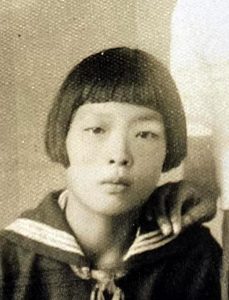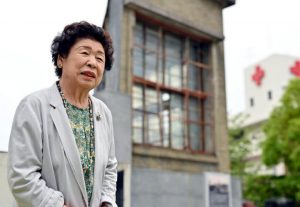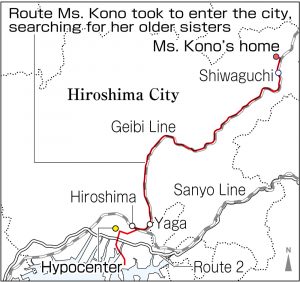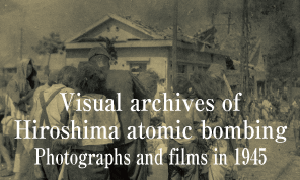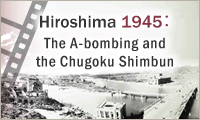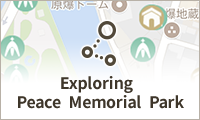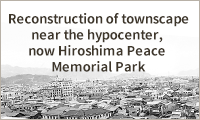Survivors’ Stories: Kiyomi Kono, 93, Naka Ward, Hiroshima City
Jul. 22, 2024
She painted a picture of the A-bombing and spoke for the boys who were killed as a result of it
by Hiromi Morita, Staff Writer
The boys appeared in her dream, saying, “Please paint a picture of us”
Kiyomi Kono (née Tanigawa), 93, an atomic bomb survivor who has been conveying her experience to the public at the Peace Memorial Museum, located in Naka Ward, Hiroshima, experienced the devastation firsthand when she entered the city at the age of 14 in search of her two older sisters and was exposed to the radiation of the atomic bombing. Though she had kept the terrifying experience hidden away and hesitated to talk about it, she felt she must tell her story on behalf of those whose lives were cruelly taken and has continued to share her story with younger generations through paintings and writing since she turned 70.
At that time, Ms. Kono was a second-year student at Mukaihara Girls’ High School (now Mukaihara High School). She lived in the village of Ichikawa in the Takata district (now part of Asakita Ward), 35 kilometers from the hypocenter. On the day of the bombing, she was taking care of her 3-year-old nephew. When they were about to eat their rice balls for breakfast together, she heard an explosion that sounded like 10 or 20 thunderbolts had struck.
After a while, an ominous cloud began to rise from beyond the mountains. Ms. Kono said, “I was worried because I didn’t know what had happened.” In the evening, many injured people were carried from the Hiroshima area to Shiwaguchi Station, her nearest station on the Geibi Line. She learned a large bomb had been dropped on Hiroshima.
The next morning, Ms. Kono boarded a train to Hiroshima with her mother to search for her two older sisters who had been there. Since Hiroshima Station was burned down, the passengers were made to get off at the preceding station, Yaga (now in Higashi Ward), and entered the city on foot. Pushed by the crowd, Ms. Kono and her mother arrived in the city, where people were scorched and half-naked. She said, “They didn’t seem like human beings like us.”
People lying here and there were red and puffy, their eyes and internal organs flowing out. “I was so scared I couldn’t see my feet and walked clinging to my mother,” said Ms. Kono. Charred bodies, odor, and groaning. “It was the most terrifying experience of my life.”
When Ms. Kono and her mother arrived at Hiroshima Red Cross Hospital (now in Naka Ward), where one of her older sisters worked, they found it full of injured people. Her older sister was injured but safe. When they went out of the hospital, they found the bodies of the boys piled radially like logs in what used to be a flower bed.
When Ms. Kono approached and looked at the nameplates, they read Hiroshima Second Middle School (now Kanon High School). She said, “I was terribly shocked to see boys my age with innocent faces.” Later, she learned many junior high school students, including girls, were mobilized to engage in building-demolition work near the hypocenter and were killed.
After that, Ms. Kono and her mother confirmed her other older sister, who lived in Ujina (now part of Minami Ward), was safe and returned home late at night. It was painful for her to even remember, and for a long time she hesitated to talk about her experience, saying, “I wasn’t directly exposed to the A-bombing, and I didn’t suffer from any burns or injuries.” However, 60 years after the bombing, she decided to try to paint a “picture of the A-bombing” in response to a call for submissions by the public broadcaster NHK.
However, she had a hard time making progress with her painting. Then one day, the boys appeared in her dream and said, “Please paint a picture of us as soon as possible. Speak for us.” The picture she painted then inspired her to compile the scene she saw at the age of 14 into a picture book titled Ano Hi wo Watashi wa Wasurenai (in English, I Will Never Forget That Day) and began to share her A-bomb account. She stressed, “I want people to know about the boys and girls who had to suppress their desire to study, worked for their country, and lost their lives.”
She feels a sense of despair about the world situation, where the disasters of war continue and there is a politician who plays around with nuclear weapons. She said, “But human beings created nuclear weapons and used them. So, it’s rational for human beings to abolish them. Even if some people say it’s ideal, I want the younger generations to continue saying they don’t need nuclear weapons.” This is her fervent wish.
(Originally published on July 22, 2024)

